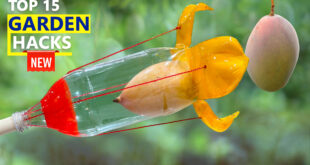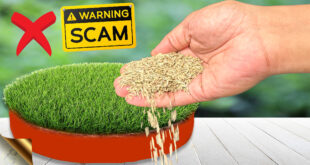Today we will look into making an All-Purpose Universal Fertlizer for all your home plants for boosting growth or increasing flowering and fruiting. This topic is little controversial as we are using a mixture of Organic and Inorganic NPK fertilzers. And we shall try to prepare a balanced Universal fertilizer combination that will balance the benefits of both organic and inorganic fertilizers. This is based on my own scientific research and methods and the university research article links are provided in the video description and also the links to purchase stuff online if its not available in your place. At the end will try to calculate this recipes approximate total NPK value.
For both beginner and experienced gardeners, a good nutrient rich soil is one of the most important factors for gardening success. Well – this applies when you are using the best soil with all nutrients to be readily available to the plants. You can watch my video on Universal Potting Soil by checking a link in the video description and also from a card linked at top right corner of this video after this video.
Well, Back to the topic: What if you have not prepared the best potting soil for your plants and your plants are suffering from malnutrition and deficiencies. Also even if you already have the best soil available to your plants, what about supplementing it with nutrients, I Mean Fertilizing your plants for the best growth and development is very important.
Whether to practice organic gardening methods or to rely upon chemical products is a major decision in soil management. Weighing the advantages and disadvantages of natural and chemical fertilizers will help you decide which method is appropriate for your garden.
There are many advantages as well as disadvantages of both Organic and Inorganic Fertilizers. We will not go into the details of these right now. Will try to discuss these in another detailed video. For now, based on some research articles on Mixed Organic and Inorganic Fertilizer preparation, to utilize the benefits of both and considering the NPK proportions and micronutrients or trace element proportions, we will try to formulate a preparation to fertilize your plants and use this mix as an all-purpose universal fertilizer powder to fertilize your plants on a monthly or fortnightly basis. If you want to know What is NPK and some basics, there s my separate video on NPK fertilzers – you can check the link in description or from a video card link at top right corner.
The basic idea is to make a balanced general purpose or universal fertilizer. Like you get a general purpose NPK crystals of 19-19-19 or 12-12-12 proportions and so on – indicating Nitrogen 19 percent, Phosphorus 19 percent and Potash 19 percent and things like that. If you are an expert you can do more calculations and research and also consider your purpose or even make a plant specific combinations by varying these proportion. For this you should know the approximate concentration of NPK in each of these organic stuff you are adding. Also there are Fertilizer mixing apps on google playstore.
Well, Now lets look into the ingredients, we will be using. And if you do not have some of these, do not worry, you can use whatever is available based on the content of NPK in each. For this you can check the NPK percentages and then total it in the end to know the actual or approximate NPK value of your final fertilizer mixture. Also One more concept to keep in mind in Unlike chemical fertilisers, the ‘natural’ fertilisers tend to dissolve slowly and thereby release their nutrients – that’s slow releasing and chemical NPKs are readily available. This way we are balancing the nutrient availability and avoiding the adverse effects of chemical fertilzers by using a lesser amount of inorganic fertilizers.
- COW DUNG: Whatever animal manure you are using, take a look at the NPK ratio of these. Here we are using decomposed cow dung. So NPK is 3-2-1. Whatever, we will not bother much about these figures. For your reference have a look at the NPK values of each of these animal manures.
- COMPOST ( Whether home made compost or VERMICOMPOST): Here we are adding vermicompost which also contains many useful trace elements. Have a look at the tables for your reference. So NPK is 1.78, 0.77,0.94
- BONE MEAL, you can use any of the other meals like sterameal, fishmeal, bloodmeal. So the NPK for bonemeal is 3.5, 18, 0
- We will add both bone steamed meal powder as well as coarse bone meal chips powder mixed. Do not worry, you can add any one. This is just to make it quicker for release of bone meal nutrients.
- Now we shall also add some optional stuff into this for additional fortification and also as soil pesticide or pest repelling agents, particularly neem cake powder or Karanj powder. Then we will also add Mustard cake powder. We will discuss the benefits of each of these in separate videos.
- Well, the first one Neem Cake Powder: NPK of neem powder is here:
N(Nitrogen 2.0% to 5.0%), P(Phosphorus 0.5% to 1.0%), K(Potassium 1.0% to 2.0%).
- So knowing these NPK proportions, we can mix these stuff in different propertions to make your universal fertilizer mix. There are lot of formulae, calculations and maths to determine this but at home gardening level we will not bother too much about these. I am not a horticulturist or an expert in this field. I am a medical doctor with gardening as my hobby and passion.
Anyways, We will try to make an approximate mix with approximate proportions and use this on our plants.
If you are a Pure Organic fertilizer lover, then you can prepare “organic only” fertilizer for your plants and offer extra dose to your plants. But if you want to prepare a balanced universal mix – that is inorganic + organic mixture, you need to offer this in lesser quantity to your plants – like half to one tablespoon depending on the size of your pot and after tilling or raking the top soil and apply around the plant – not directly on roots. You can apply every 15 days to 1 month – by carefully evaluating your results and then adjust the dosage accordingly.
Well, now we will mix all these with approximate weight of each of these in gms to make this fertilizer mix of organic + inorganic – a total of upto 10 kilograms.
- Urea (NPK 46-0-0) – 200 gms
- NPK Powdered Crystals or water soluble powder (19 19 19) – 500 gms. You can also crush the NPK crystals before adding.
- DAP (18-46-0) – 500 gms – even this you can crush the crystals and add.
- Cow Dung powder – 2000 gms
- Compost (vermicompost) – 2000 gms (if you donot have micronutrient powder, you can increase this to 3000 or 4000gms)
- Bone Meal – 1000gms
- Neem Cake Powder or Karanj Powder – 1000gms (Here will add 500gms each of these)
- Then optionally you can perform a soil PH test and mix either woodash or lime to make your soil more alkaline if its too acidic and if your soil is too alkaline, you can add alum powder into this mix.
And one more important point from storage point of view: you might feel some moisture in this mixture due to some moist ingredients. You can either use completely dry ingredients before mixing or you can dry this mixture in sunlight and then store in air tight containers. Remember to mix the ingredients thoroughly well for best results.
Now we will roughly total up the NPK value for this mix. We will try to total up based on 1000 gms of each of the ingredients: have a look at this equation in the table:
Ingredient (per 1000g) N
P
K
Urea (200g) 9.2
0
0
NPK(19-19-19) -500g 9.5
9.5
9.5
DAP (18-46-0) -500g 9
23
0
Cow Dung (3-2-1)-2000g 6
4
2
Vermicompost -2000g 3.5
1.5
2
Bone Meal -1000g 3.5
18
0
Neem, Mustard etc 9
1.5
3
TOTAL 49
57
17
So the Approx Total NPK value of this Mix is 49-57-17. If you want to reduce the Nitrogen value, you can skip adding Urea and things like that. So the Take home message is this – “This Mix is Powerful mix of organic and inorganic fertilizer balancing the advantages and disadvantages of chemical fertilzers and secondly it saves your time and energy and you offer everything at once to your plants.”
So, there we have it folks, that was an attempt to make our own universal fertilizer mix for our home garden plants.
- Mustard Cake Powder – 1000 gms
- Epsom Salt – 200 gms
- Then Lastly we will optionally fortify this further with optional Micronutrient Powder available from a reliable company to add micronutrients like Mn, zinc, Fe, boron and many others to safeguard our plants from any deficiencies. Also you can add more ingredients you wish to like used tea powder and any other stuff, because this is a one time mix and you offer this on a periodic basis and only once in 15 days or so and you add almost all nutrients and this reduces burden and saves you a lot of time, plus this is a quality mix.
 GKVKs – Gardening Tips and Store Gardening Tips and Store
GKVKs – Gardening Tips and Store Gardening Tips and Store



